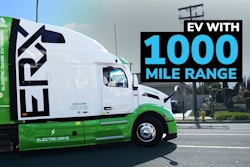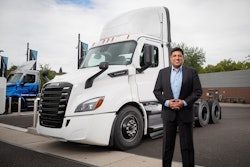The Inflation Reduction Act offers up to $40,000 in tax credits for the adoption of commercial zero-emission vehicles, and while there are countless benefits of owning and operating an electric truck, one major roadblock stands in the way of making the purchasing leap for buyers: the lack of public charging stations.
The question of how a fleet will charge an electric big rig along routes outside of the carrier's own depot can be enough for potential customers to think twice about electrification. Though electric truck adoption is still in its infancy, the market is flooding with new models from leading OEMs, and the number of electric trucks on the road is expected to grow to 54,000 by 2025 from just over 2,000 in 2019, according to a report from Wood Mackenzie. To address this anticipated growth, we must accelerate the installation of the public charging infrastructure nationwide.
First, we need to address the need for more public charging stations for electric trucks. Until recently, planning, incentives, and deployment of charging infrastructure have centered around the installation of light-duty electric vehicle charging infrastructure, with more than 55,000 public chargers available today in the United States–approximately 7,800 direct-current fast-charging stations. While trucks can use these charging stations, they primarily serve passenger vehicles; a much smaller number of charging stations are dedicated to semi-trucks. Since the trucking industry is responsible for moving over 70 percent of all goods in the United States, it’s imperative for both the economy and the environment that we work to speed up the installment of public charging stations nationwide for electric trucks.
Installation of public sites is possible through shared or multi-use charging stations. Heavy-duty truck charging stations can be installed at existing truck depots and warehouses, where charging capabilities can provide overnight charging at adequate speeds. WattEV recently announced the United States’ largest charging station of its kind for electric heavy-duty trucks at California’s Port of Long Beach, following 14 months of planning and development. The site can charge 26 trucks concurrently. Future megawatt charging at the depot is being planned.
Building fixed charging sites near businesses is another option. In 2021, Daimler Trucks North America (DTNA) and Portland General Electric opened “Electric Island” near DTNA’s headquarters, the first-of-its-kind electric-truck charging site for all types of electric vehicles (EVs), including electric cars, buses, box vans, and semi-trucks. The site was designed to allow chargers to be easily replaced with future technologies, helping to accelerate the clean energy transition.
High-power charging infrastructure should also be installed at major ports and highways where these types of vehicles regularly travel. These corridors tend to align with where low-income communities and communities of color reside (explore the Climate and Economic Justice Screening Tool for more information); this results in their higher exposure to harmful air pollutants from diesel trucks, resulting in asthma, cardiovascular diseases, and lung cancer.
All of this reinforces the imperative: We need a variety of solutions, and it will take key players working together to accelerate electric vehicle growth with supporting infrastructure.
California has made remarkable strides over the past few years in solving these problems and is a center for opportunities to accelerate the growth of electric truck public charging infrastructure.
The Golden State is home to, among others, ChargePoint, a company founded in 2007 that boasts being the leading EV charging network for fuel stations to build “the fueling network of the future”; San Diego Gas and Electric’s Power Your Drive for Fleets Program, offering specific incentives for medium- and heavy-duty fleets; Southern California Edison’s Charge Ready Transport Program, an opportunity to install the infrastructure for medium- and heavy-duty fleets; and the Energy Infrastructure Incentives for Zero-Emission Commercial Vehicles Project (EnergIIZE), which will offer a portion of its total incentive funds to public charging station developers through its Public Charging Funding Lane and Drayage Public/Shared Charging Lane, both opening in mid-October 2023.
The work by many public and private groups is what is driving the state’s strides towards improving and mitigating public health and environmental concerns, while moving closer to its net zero carbon pollution goals.
But California isn’t the only state offering rebates, incentives, tax credits, and other growth opportunities for electric truck public charging station installation. Joint Utilities of New York points out that “medium- and heavy-duty vehicle operators in New York State looking to install charging stations to electrify their fleets may be eligible for charging infrastructure funding from their utility through the Medium- and Heavy-Duty Make Ready Pilot.” Colorado’s Fleet-ZERO grant program also supports charging for fleet owners and operators looking to transition to electric vehicles.
It's evident that to accelerate the growth of medium- and heavy-duty electric truck use across the country, we must also address where public charging stations need to be installed to service those trucks and take advantage of the funding opportunities available in each state.













